In this article, we will be diving into the details of the new GTO Poker strategies in the 6-max cash library in the GTOBase application. Specifically, we will be discussing the preflop and postflop game trees configurations to justify to the players the value and quality of our solutions library. We will also be explaining why some lines on the preflop were removed, how we chose sizings in situations where the solver does not always choose a single size and other intersting questions about the structure of game trees. Overall, this article will provide a comprehensive overview of the new GTO solutions in the 6-max cash library.

Preflop
New preflop solutions in the 6-max Cash Library are represented by main trees and tune trees.
Tune trees were made for NL100 and NL500 limits and they were solved to show which sizes solver prefers to play more. The most playable sizings from tune trees were used for main trees.
Main trees have been solved for the following limits/rake structure:
- NL50 – rake 5%, rake cap 6.0bb
- NL100 – rake 5%, rake cap 3.0bb
- NL200 – rake 5%, rake cap 1.5bb
- NL500 – rake 5%, rake cap 0.6bb
- NL1k – rake 5%, rake cap 0.3bb
- chip EV – no rake
Solved depths: 40bb, 50bb, 70bb, 100bb, 150bb, 200bb.
Free positions open raises: 2.00bb, 2.25bb, 2.50bb, 3.00bb
Different opening sizings from free positions correspond to different sizes of the SBvsBB play.
For stack depths 40bb, 50bb:
- FP open: 2.00bb – SB open: 2.50bb, no limp
- FP open: 2.25bb – SB open: 3.00bb, no limp
- FP open: 2.50bb – SB open: 3.00bb, limp
- FP open: 3.00bb – SB open: 3.50bb, no limp
For stack depths 70bb, 100bb, 150bb, 200bb:
- FP open: 2.00bb – SB open: 3.50bb, limp
- FP open: 2.25bb – SB open: 3.00bb, no limp
- FP open: 2.50bb – SB open: 3.00bb, limp
- FP open: 3.00bb – SB open: 3.50bb, no limp
Why are SB-BB strategies for 40bb, 50bb different from other stack depths?
Players tend to consider 40bb and 50bb as short stacks and play 2.5bb size more often in SB-BB situations. We decided to add it for these stacks in order for users to see the defense strategy.
Why some lines on the preflop are missed, e.g. MP opens, CO calls, BTN calls, SB calls, BB calls?
We have conducted experiments solving 5-way and 6-way exits on the postflop, the complexity of the game trees is significantly increased and their calculation becomes much longer to achieve equilibrium in thouse branches. Meanwhile, the absolute weight of these branches is very minimal, and you will almost never face this situation in real game, hence the maximum N-way exit in new solutions of Cash Library for postflop is 4-way.
Why is there no branch for MP open, CO call, BTN call, and for SB there is no possibility of call, only playing raise/fold strategy?
In the scenario of SB call the strategy would be flawed, as after his call, BB would have an great probability for call, and we cannot overlook flat calls for BB, thus we refrain from providing SB with the option to play this flat, in order to avoid creating such lines.
Why 3-bet cold calls included in some places, but not in others?
We conducted test calculations and came to the conclusion that 3-bet cold call are rarely played, so we removed most of them. In the main trees, we only kept 3-bet cold calls against SB by BB, and against free positions by BTN. This was done so that users could verify that such actions have minimal frequency. For example, in NL500 solution with open size of 2.50, in the branch of BTN Raise to 2.50 – SB 3bet to 12.00 – BB Call, the weight is 0.14%:
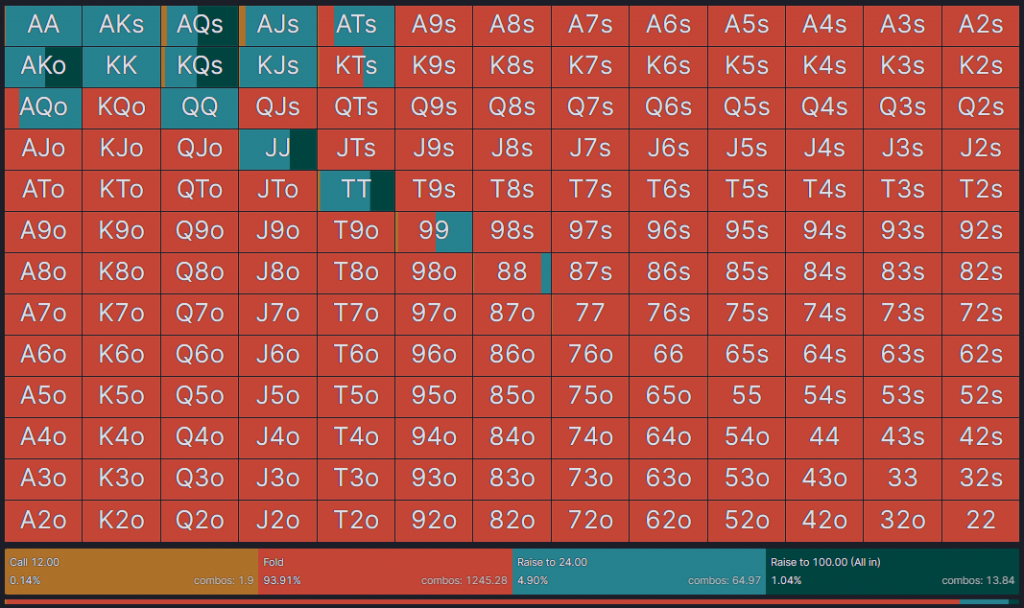
Another example, HIJ Raise to 2.50 – CO 3bet to 8.00 – BTN Call the weight is 0.40%:
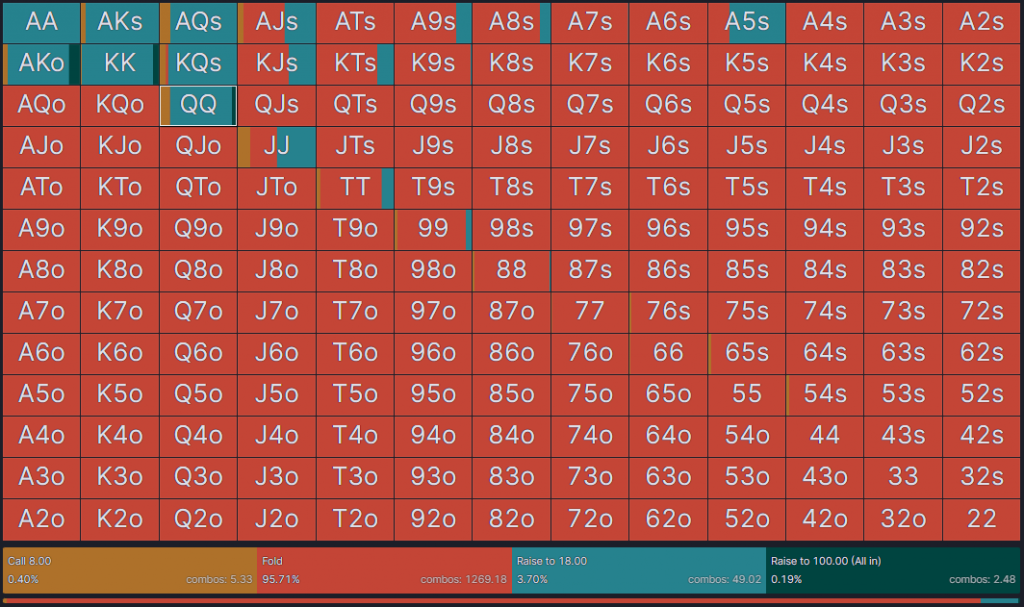
This demonstrates that even in these situations, the solver prefers to avoid 3-bet cold calls preflop.
In the tune trees, the solver does not always choose a single size and instead mixes them. How did we choose sizings in these situations?
In such cases, we based our approach on the assumption that the selection of size would not affect the overall EV of the player, hence we would consider what would be more convenient for the user. However, the chosen size may not always align with the users’ preferences.
The solver has a tendency to 3-bet with larger sizing from the button and smaller from early positions. Why does our 3-bet sizing on the BTN match the sizing of the 3-bet on HIJ?
We did not want to create a separate 3-bet sizing for each individual position because this would complicate the memorization, learning and comparison of strategies. Therefore, the decision was made that the 3-bet sizing against a certain open size would be the same for all positions. The same applies to 3-bet sizing from SB and BB. SB and BB have 3-bet with the same sizing against each free position.
Why don’t we have reraises against squeezes for free positions that were cold-called against the open? Example: CO Raise to 2.50 – BTN Call – SB Fold – BB 3-bet to 15.00 – CO Fold, BTN has no re-raise, only push.
You can verify in tune trees that these branches have almost 0%, so we removed them in main trees.
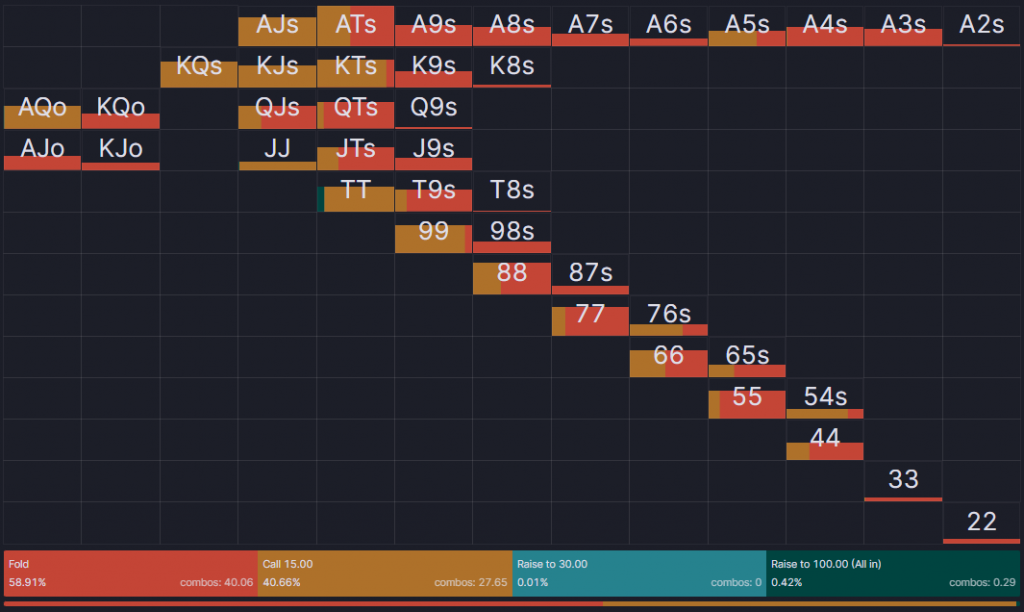
We repeatedly mention in the article that we made simplifications in trees, why did we do this?
Overall, the goal of simplifying the trees is to provide the best strategies possible in the most important situations while also making the solver more user-friendly. If the trees were very complex, then this would affect the accuracy in all branches. Also, having simpler trees makes them easier to navigate and understand.
Why does the strategy sometimes contain obvious inaccuracies in the low frequency preflop branches?
In zero-frequency branches, the strategies may not be the most logical or optimal, as their improvement would not increase the player’s EV, as the branch’s feasibility is null, yet the strategy itself is accurate enough to prevent the opponent from profiting by entering that branch.
Postflop
Currently, we have solved postflops for NL500 with an open raise size of 2.50bb.
Solved spots:
- all SB vs BB spots
- SRPs
- 3-bets against open-raisers
- 4-bets for open-raisers
- cold 4-bets against 3-bet non-squeezes
- squeezes

What are the postflop sizings configurations?
We utilized a configuration of three bet sizes 33%, 75%, 150% and two raise sizes 33%, 100% (in the case of a donk bet, we only used 33% sizing). We deliberately chose these three significantly different bet sizes in order to study where the solver prefers to play a linear strategy (a small bet sizing), where a polarized strategy (a large bet sizing), and where a medium bet sizing. Similarly, for raises, we have a linear size and a polar size.
In limped pots, we used bet sizes 33%, 100%, 200% and raise sizes 50%, 100%.
Why do we use 150% sizing on flop even though many players don’t use it in their strategy?
We are aware of this trend and were forced to make a clear decision to add an overbet on the flop or not. We decided to keep the overbet because if the solver prefers to play this size on certain flops, then removing this size would be strange.
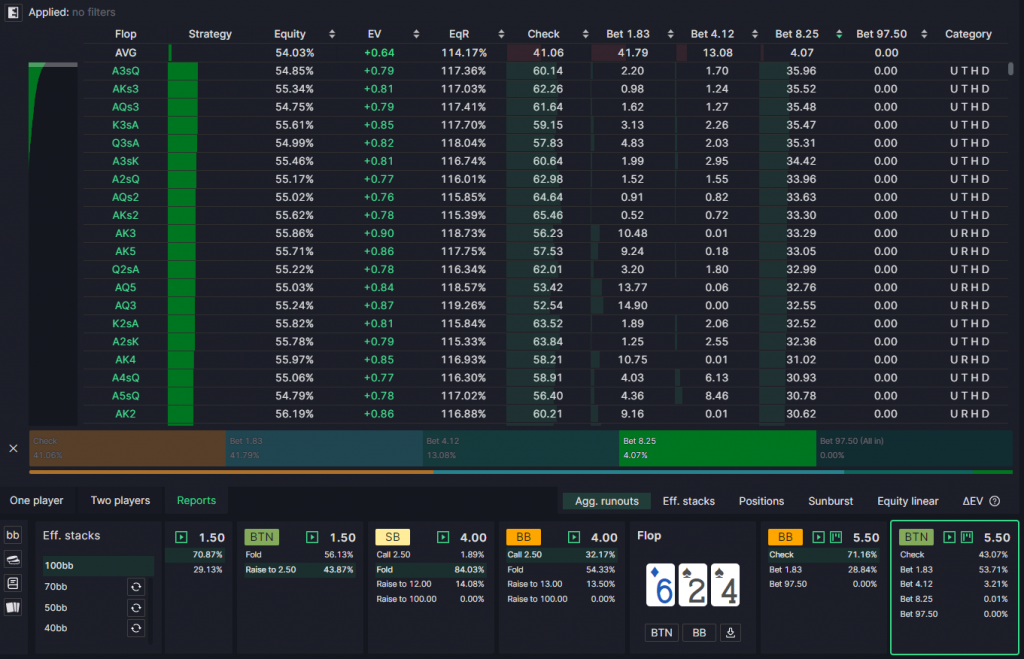
Why do we use raise sizings of 33%, 100% and not 50%, 100%? 33% and 100% raise sizings looks too far apart from each other, one is too small and the other is too big.
Initially, we decided to make trees with 2 raises, so we had to choose the best config for this condition. We did some calculations on trees with more reraises and came to the conclusion that there are boards where it is important to play with small raise sizing. The most striking example of this would be paired flops. in addition to paired flops, it is important to note that against large bets, the solver also prefers to play with small raises. We are not claiming that 33%, 100% is the best config, but there are boards where the solver plays small raises, and there are boards where the solver plays big raises, so we didn’t want to neglect these two extremes.
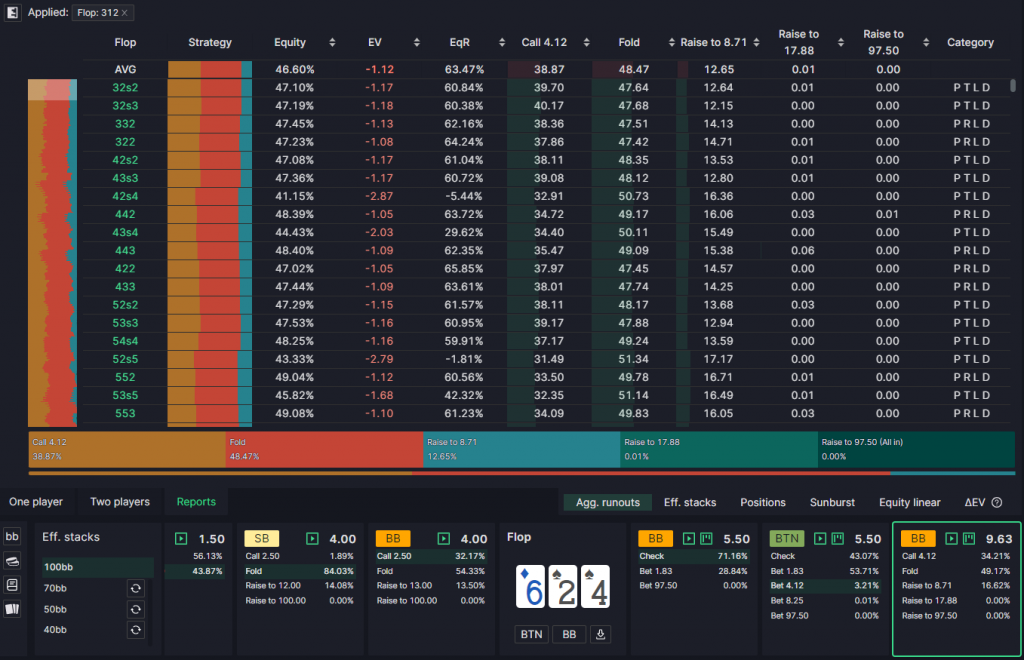
Why in some cases we used sizings of bets other than of 33%, 75%, 150%?
For example, preflop: SB Raise to 3.00 – BB 3-bet to 10.0 – SB Call, flop: SB Check – BB Bet 15.00 – SB Call. On the turn, bet sizes are 25% and 50%. In this situation, if we had bet sizes of 33% and 75%, the solver would often prefer a bet size of 33% on the flop, as it allows for a larger bet of 75% on the turn. While, after a flop bet of 75%, on the turn, it would have either an underbet or a push of 150%. This would have been a significant oversight, therefore, in cases when the pot becomes too small to play bets of 33% and 75%, we use bet sizes of 25% and 50%.
What sizing settings are used for the rivers?
We calculate river strategies on the river in real-time. We use the following settings for river sizings:
- OOP bet sizings: 25%, 50%, 100%, 150%
- IP bet sizings: 50%, 75%, 100%, 150%
- Sizings of raises: 100% and 150%.
Why do the betting sizes differs for players in position and out of position?
For OOP player an underbet on the river is a very important sizing, while for a player in position it is rarely played and will most often be played at 0% frequency. We have decided to change the underbet sizing for the player in position to 75% sizing that will be played very often.
Conclusion
The new solutions in the 6-max cash library in the GTOBase application are available for limited time for free and would be a valuable to start learning GTO strategies using one of the most cutting edge tool without any spendings. By understanding the solutions provided by the solver, players can gain a deeper understanding of the game and make more informed decisions at the table. We provided tune trees have been solved to show the preferred sizings for different stack depths and positions, and the main trees have been fine-tuned to provide the most playable options for players. It is important to note that while the solutions provided by the solver are based on the pure math (game theory), they may not always align with a player’s personal preferences. However, by understanding the reasoning behind the solutions, players can make more educated decisions about how to adapt the strategies to their own game. Overall, the new GTO Poker strategies in the 6-max cash library in the GTOBase application are a valuable resource for players looking to improve both preflop and postflop game strategy.

